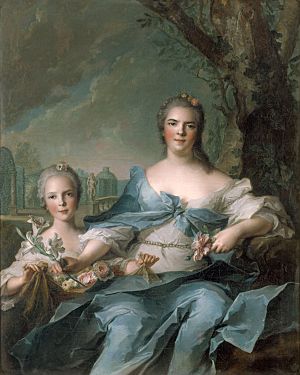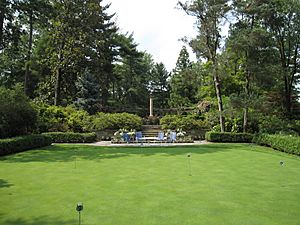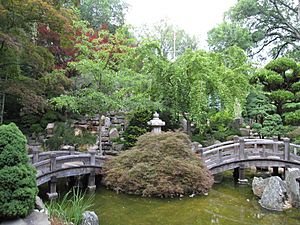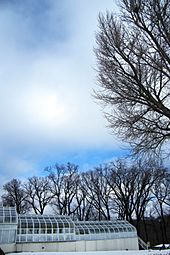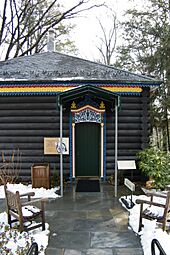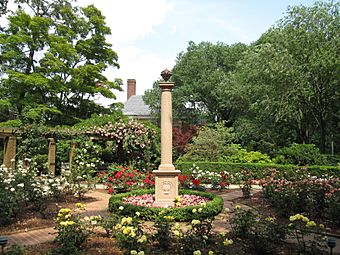- This page was last modified on 17 October 2025, at 10:18. Suggest an edit.
Hillwood Estate, Museum & Gardens facts for kids
 |
|
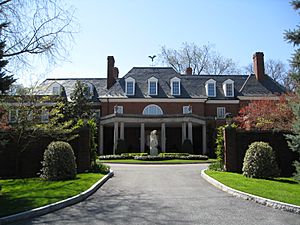
Hillwood Estate
|
|
| Lua error in Module:Location_map at line 420: attempt to index field 'wikibase' (a nil value). | |
| Established | 1973 |
|---|---|
| Location | 4155 Linnean Ave. NW Washington, D.C. 20008 |
| Type | Decorative Arts |
| Public transit access | |
Hillwood Estate, Museum & Gardens is a museum of decorative arts in Washington, D.C. It was once the home of Marjorie Merriweather Post, a successful businesswoman and art collector.
The museum is famous for its huge collection of art, especially items that belonged to the House of Romanov, the royal family of Russia. This includes two amazing Fabergé eggs. Visitors can also see beautiful 18th and 19th-century French art and one of the best orchid collections in the United States.
Contents
The Story of Hillwood
In 1955, Marjorie Merriweather Post bought a large house in Washington, D.C. and named it Hillwood. She had used the same name for a home she owned in New York. The house was originally built in the 1920s, but Post wanted to make it her own.
She hired an architect to completely redesign the inside of the 36-room mansion. The changes were finished in 1956. Post wanted the house to be a perfect place to display her amazing art collections from France, Asia, and especially Russia.
A Famous Home
Post collected many Russian treasures while she was married to Joseph E. Davies, who was an ambassador to the Soviet Union. She bought beautiful items, like a chandelier from Catherine Palace and famous Fabergé art. One of her most prized possessions was the Twelve Monograms Easter egg.
Hillwood quickly became known as one of Washington's most special homes. Post loved to host parties and welcome guests. As a gift for her 70th birthday, 181 of her friends built a path called "Friendship Walk" in her garden.
Becoming a Museum
Post wanted everyone to enjoy her home and art collection even after she was gone. In 1962, she decided to leave Hillwood to the Smithsonian Institution to be turned into a museum. She also left a large amount of money to take care of the estate.
After Post passed away in 1973, the Smithsonian found it difficult to manage the estate as she had wished. In 1976, Hillwood was given back to the Post Foundation, an organization Post had created. The foundation now runs Hillwood as a museum, just as she wanted.
Amazing Art Collections
Hillwood has over 17,000 objects in its collection. You can see art that Post collected herself, as well as items added after her death.
Some of the most famous pieces include:
- Portrait of Catherine the Great: A life-sized painting of the powerful Russian empress, Catherine the Great, in her royal clothes.
- Chests of Drawers: Two beautiful chests made by Jean-Henri Riesener, who was the personal furniture maker for King Louis XVI and Queen Marie Antoinette of France.
- The Duchess of Parma and Her Daughter: A famous painting by Jean-Marc Nattier.
- A Boyar Wedding Feast: A large, detailed painting by Konstantin Makovsky that shows a traditional Russian wedding celebration.
- Imperial Easter Eggs: Two incredible eggs made by the House of Fabergé. They were gifts from Tsar Nicholas II of Russia to his mother, Maria Feodorovna.
- Sèvres Porcelain: Bright blue dishes made by the famous French company Manufacture nationale de Sèvres.
- Russian Orthodox Art: Religious items like icons and decorated cups used in the Russian Orthodox Church.
The collection also includes huge tapestries from the 1730s, fancy jewelry, and rare lace tablecloths.
Gardens and Grounds
The 25 acres of land around Hillwood are just as impressive as the mansion. Post worked with landscape architects to create a series of beautiful "garden rooms," each with its own special style.
Motor Court
This is where guests would first arrive. The driveway curves up a hill to an oval-shaped court. In the center is a statue of Eros, the Greek god of love. The area is planted with colorful azaleas and dogwood trees.
French Parterre
This formal garden is designed in a classic French style. It has low, neatly trimmed plants arranged in patterns, with gravel paths in between. A statue of the Roman goddess Diana watches over the garden. This garden was Post's tribute to 18th-century France.
Rose Garden
Post hired the same person who designed the White House rose garden to create this beautiful space. It is filled with many types of roses that bloom all summer. Post's ashes are buried here under a pink granite monument.
Putting Green
Post enjoyed playing golf, so she had a small putting green installed on the grounds. It is surrounded by magnolias and Japanese holly trees.
Lunar Lawn
This large, crescent-shaped lawn was named for its shape, like a crescent moon. It was the perfect spot for outdoor parties. From the lawn, you can see the Washington Monument in the distance. The flowers on the lawn are changed with the seasons, a tradition started by Post.
Japanese-Style Garden
This peaceful garden was designed to feel like a natural landscape in Japan. It has a waterfall, a quiet stream, and stone paths. The garden features a mix of Japanese and American plants, like Japanese pines and Colorado blue spruce trees.
Pet Cemetery
Post loved her dogs and created a special place to remember them. In a quiet part of the grounds, you can find small limestone memorials for her beloved pets. The last pet buried here was her schnauzer, Scampi, in 1972.
Dacha
A dacha is a traditional Russian country house. This building was added to the grounds in 1969. It looks like a rustic log cabin and is used for special exhibits about Russian art and culture.
Greenhouse
The greenhouse provides fresh flowers for the mansion all year long, just as Post wanted. It was rebuilt in 1996 to look exactly as it did when she was alive. It is also home to Hillwood's famous collection of beautiful and rare orchids.


